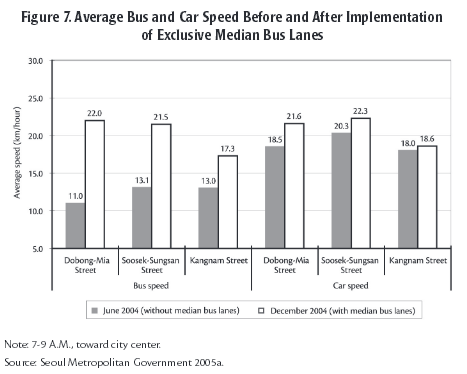Removing car lanes and dedicating them to transit can speed up everyone's commute:
In Seoul's case this was done with "Bus Rapid Transit" (BRT) where buses operate in dedicated lanes and private traffic is not allowed in those lanes. But surface LRT on major roads would achieve a similar effect since it would remove the need for buses to operate on those roads (say, Finch Ave W or Sheppard Ave E in Toronto). Seoul's experience was that bus speeds of course increased tremendously, but so did car speeds:
Private Funding of Transit Infrastructure is No Panacea:
Similar to Mayor Ford's difficulties in finding a for-profit partner to build (or even share costs) on his desired subway expansions, Seoul has found this difficult too. The above is about LRTs, but even in subways bringing in PPPs is risky, as Seoul has discovered with the privatized "Line 9" subway, constructed in a PPP and where government is required to guarantee revenue to the privatized operators if ridership doesn't meet projections:
As they say of PPPs, the net result is to privatize the profits and socialize the risks. The experience has already had Seoul nearly come to just buy out the private entities once over a planned fare increase, and as the previous link shows, they are currently changing the structure of the deal due to sustained pubic dissatisfaction with the arrangement. These changes are causing one of the partners to pull out, poor dears:if ridership is lower than predicted, the city has had to pay the company tens of millions of dollars each year. MKIF and other investors made 13.1 billion won (US$11.8 million) from the line in 2010, 29.2 billion won (US$26.2 million) in 2011, and 38.4 billion won (US$34.5 million).
But the biggest change is a deep cut in the rate of return guaranteed to private investors, from its current annual level of just over 13% (8.9% after taxes) all the way down to just under 4%.If it takes a 13% annual ROI to keep free market players in the transit game, this isn't anything like viable. No way running a subway line should be this profitable - it's literally a utility.
World Class Cities Do So Use LRTs In The City:
One of the absurd arguments from subway advocates, led by Deputy Mayor Norm Kelly was that "world class" cities don't put LRT in the city proper, they use it in the outer suburbs, which for Kelly & co means the 905 belt, deeming everything in Toronto's legal boundaries to be "urban" regardless of actual density or zoning. As noted in a previous post, parts of Scarborough and Etobicoke have lower density than Mississauga or even Brampton, but apparently anything less than subways is a grave insult to these "urban" areas of large single family houses on wide lots with plenty of parkland. Despite the above mentioned problems getting private partners for all of them, they're pushing ahead on a set of up to 10 lines, from here:
That is a map of Seoul the city, proper. These are not in their equivalent of a 905 belt surrounding the city.
In fact, Seoul's has one LRT line running already, this one is admittedly outside the city proper, but it was built to serve 32 million riders a year at opening, rising to over 50 million/year in years to come, quite comparable to the projected ridership on the planned Scarborough subway extension.




No comments:
Post a Comment